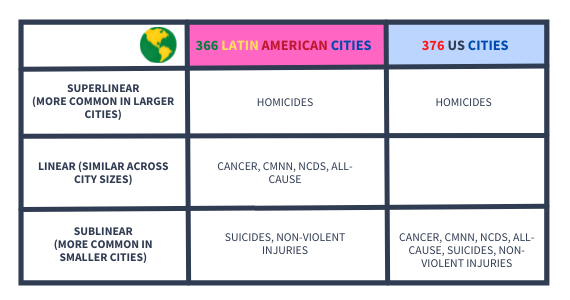The effects of urbanization on mortality: Latin America vs. United States
Posted on
December 10, 2021
By: Usama Bilal, MD, PhD, MPH
Assistant Professor
Dornsife School of Public Health
Latin America has had a very rapid and intense urbanization process in the last century. Along with North America, both regions have the highest levels of urbanization worldwide. The cities where most of the region live are complex systems that house millions of people that interact daily with each other. The complexity of these interaction gives rise to specific behaviors. The urban scaling framework allows for the exploration of how the characteristics of cities change as their size grows. As the number of people and interaction increases, a number of city characteristics, especially socially generated outcomes (e.g., wealth and crime) become more common thanks to the network effects generated by the agglomeration and intense interactions of people. These interactions also generate economies of scale, which make other characteristics, such as infrastructure (e.g., gas stations), less common as cities grow. These two behaviors are usually called superlinear scaling (more common in larger cities) and sublinear scaling (less common in larger cities) and represent two useful ways of characterizing how city features relate to city size.
In a new article published in Science Advances, we have used the urban scaling framework to study how mortality scales with city population size across the universe of 742 metropolitan areas of 100,000 residents or more in 10 countries of the SALURBAL study and the United States. We leveraged mortality and population data from these cities and explored the scaling of all-cause mortality (deaths due to any cause), six large groupings of causes of death (e.g., cancer), and 41 fine-grained causes of death (e.g., liver cancer). We explored these scaling behaviors accounting for the different age structure of each city, to acknowledge that age is the most important risk factor for mortality, and also compared results for the US, Latin America, and Brazil and Mexico specifically.
We found four key results. First, all-cause mortality was relatively lower in larger US cities, but did not vary much across cities of different size in Latin America. However, when looking at groupings of causes of death, the results became more interesting. Deaths due to unintentional injuries (e.g., road traffic fatalities, overdoses, falls, etc.) and also suicides were relatively less common in larger cities of both the US and Latin America, while homicides were relatively more common in larger cities. This consistency between regions was also seen for deaths due to STDs and HIV/AIDS (more common in larger cities) and a few other specific causes of death such as nutritional conditions, cancer of the esophagus, and cirrhosis of the liver (less common in larger cities). However, we found that most other causes of death followed a different pattern: they were less common in larger US cities but did not vary much by city size in Latin America.

The article contains a deeper discussion on these results and potential reasons behind these patterns as well as some potential implications. First of all, it represents a good starting point to do a deeper exploration into what factors are driving these differences by city size (risks factors in larger cities or a diagnostic limitations in smaller cities). Second, they provide further evidence about whether there’s a universal scaling behavior of health outcomes in two very different regions. While we highlighted that the patterns varied for some causes of death, it is important to note that the order of which factors were more or less common in larger cities in the US and Latin America did not differ much. Third, and regardless of these differences, knowing whether certain types of causes of death are more common in larger vs smaller cities can help prioritize resources and allow a more nuanced understanding of the drivers of health in cities.
As the world continues to urbanize, understanding health consequences, beyond simple rural to urban comparisons, will be key for the design of sustainable, equitable, and healthy cities in Latin America and worldwide.